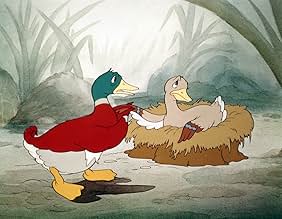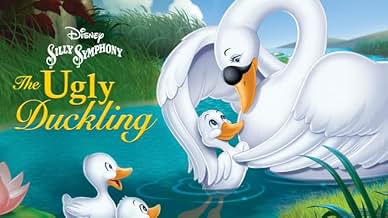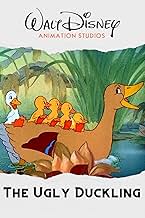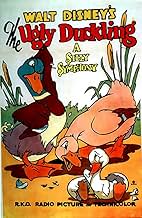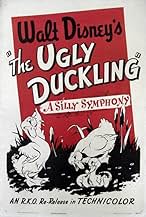AVALIAÇÃO DA IMDb
7,6/10
4 mil
SUA AVALIAÇÃO
Adicionar um enredo no seu idiomaA baby duckling is shunned by his family because he is different. He is also rejected by all of the other birds and animals. Finally a mother swan adopts him as one of her brood.A baby duckling is shunned by his family because he is different. He is also rejected by all of the other birds and animals. Finally a mother swan adopts him as one of her brood.A baby duckling is shunned by his family because he is different. He is also rejected by all of the other birds and animals. Finally a mother swan adopts him as one of her brood.
- Direção
- Roteiristas
- Artistas
- Ganhou 1 Oscar
- 1 vitória no total
Amanda Cewel
- Mother Duck (speaking)
- (não creditado)
Tom Cotry
- Father Duck (speaking)
- (não creditado)
- Direção
- Roteiristas
- Elenco e equipe completos
- Produção, bilheteria e muito mais no IMDbPro
Avaliações em destaque
For ten years, Walt Disney's talented animators pumped out cartoon after cartoon for his 'Silly Symphonies.' Walt decided it was time to shut down one of animation's most successful series. The final film of the 'Silly Symphonies' was April 1939's "The Ugly Duckling." The series went out with a bang, with the duck short winning the Academy Award for Best Short Subject (Cartoon), the 'Silly Symphonies' eighth Oscar win. The 75-cartoon series proved to be an invaluable testing ground for Disney to create and test new techniques and technologies, resulting in Walt's first feature film, 1938's "Snow White and the Seven Dwarfs."
Disney's animators, led by Jack Cutting and Ham Luske, had completed Hans Christian Andersen's fairy tale cartoon the year before. But Walt elected to hold off its release until he secured a Radio City Music Hall premier during the Easter Week which happened to front-end Fred Astaire and Ginger Rogers' "The Story of Vernon and Irene Castle." The 1939 version of "The Ugly Duckling" was his second telling of the 1843 Andersen story about a newly hatched white duckling who clearly didn't belong to the brood of baby mallard ducks the mother had just delivered. The most recent version was much sadder than its 1931 black-and-white predecessor, which played up the humorous aspects of the tale. But the Oscar-winning 1939 cartoon's ending was more in line with the written Andersen work than the earlier one.
"The Ugly Duckling" of 1939 concluded the 'Silly Symphonies'' storied series beginning in 1929 with "The Skeleton Dance." The string of successive cartoons was intended to be a platform for mainly musically-based animations with very little yapping. Over the course of its ten-year lifespan, the symphonies introduced a variety of innovations in animation, including the first three-strip Technicolor cartoon in 1932's "Flowers and Trees," special effects, more realistic human and animal movements, the multi-plane camera, and on and on. Only the cartoon series 'Tom and Jerry' would achieve the number of Academy Award wins as the 'Silly Symphonies.' After the overwhelming success of "Snow White," Walt decided to concentrate on his ambitious full-length films and his Mickey Mouse shorts. Some say the spirit of the series was carried on by his all-musical animated feature film, 1941's "Fantasia."
Disney's animators, led by Jack Cutting and Ham Luske, had completed Hans Christian Andersen's fairy tale cartoon the year before. But Walt elected to hold off its release until he secured a Radio City Music Hall premier during the Easter Week which happened to front-end Fred Astaire and Ginger Rogers' "The Story of Vernon and Irene Castle." The 1939 version of "The Ugly Duckling" was his second telling of the 1843 Andersen story about a newly hatched white duckling who clearly didn't belong to the brood of baby mallard ducks the mother had just delivered. The most recent version was much sadder than its 1931 black-and-white predecessor, which played up the humorous aspects of the tale. But the Oscar-winning 1939 cartoon's ending was more in line with the written Andersen work than the earlier one.
"The Ugly Duckling" of 1939 concluded the 'Silly Symphonies'' storied series beginning in 1929 with "The Skeleton Dance." The string of successive cartoons was intended to be a platform for mainly musically-based animations with very little yapping. Over the course of its ten-year lifespan, the symphonies introduced a variety of innovations in animation, including the first three-strip Technicolor cartoon in 1932's "Flowers and Trees," special effects, more realistic human and animal movements, the multi-plane camera, and on and on. Only the cartoon series 'Tom and Jerry' would achieve the number of Academy Award wins as the 'Silly Symphonies.' After the overwhelming success of "Snow White," Walt decided to concentrate on his ambitious full-length films and his Mickey Mouse shorts. Some say the spirit of the series was carried on by his all-musical animated feature film, 1941's "Fantasia."
A Walt Disney SILLY SYMPHONY Cartoon Short.
A gawky UGLY DUCKLING, only moments after birth, is hectored & harried from the family of ducks he was born into. Will he ever find happiness & learn his true destiny?
This is a pleasant cartoon, with the plucky personality of the protagonist firmly front & center; the by-play between the duck parents is also amusing. Based on the Hans Christian Andersen classic, it is a remake of a 1931 black & white Symphony. The SILLY SYMPHONIES ended with this film, but they went out with a bang - like 6 of its predecessors, THE UGLY DUCKLING was awarded an Oscar for Best Animation.
The SILLY SYMPHONIES, which Walt Disney produced for a ten year period beginning in 1929, are among the most fascinating of all animated series. Unlike the Mickey Mouse cartoons in which action was paramount, with the Symphonies the action was made to fit the music. There was little plot in the early Symphonies, which featured lively inanimate objects and anthropomorphic plants & animals, all moving frantically to the soundtrack. Gradually, however, the Symphonies became the school where Walt's animators learned to work with color and began to experiment with plot, characterization & photographic special effects. The pages of Fable & Fairy Tale, Myth & Mother Goose were all mined to provide story lines and even Hollywood's musicals & celebrities were effectively spoofed. It was from this rich soil that Disney's feature-length animation was to spring. In 1939, with SNOW WHITE successfully behind him and PINOCCHIO & FANTASIA on the near horizon, Walt phased out the SILLY SYMPHONIES; they had run their course & served their purpose.
A gawky UGLY DUCKLING, only moments after birth, is hectored & harried from the family of ducks he was born into. Will he ever find happiness & learn his true destiny?
This is a pleasant cartoon, with the plucky personality of the protagonist firmly front & center; the by-play between the duck parents is also amusing. Based on the Hans Christian Andersen classic, it is a remake of a 1931 black & white Symphony. The SILLY SYMPHONIES ended with this film, but they went out with a bang - like 6 of its predecessors, THE UGLY DUCKLING was awarded an Oscar for Best Animation.
The SILLY SYMPHONIES, which Walt Disney produced for a ten year period beginning in 1929, are among the most fascinating of all animated series. Unlike the Mickey Mouse cartoons in which action was paramount, with the Symphonies the action was made to fit the music. There was little plot in the early Symphonies, which featured lively inanimate objects and anthropomorphic plants & animals, all moving frantically to the soundtrack. Gradually, however, the Symphonies became the school where Walt's animators learned to work with color and began to experiment with plot, characterization & photographic special effects. The pages of Fable & Fairy Tale, Myth & Mother Goose were all mined to provide story lines and even Hollywood's musicals & celebrities were effectively spoofed. It was from this rich soil that Disney's feature-length animation was to spring. In 1939, with SNOW WHITE successfully behind him and PINOCCHIO & FANTASIA on the near horizon, Walt phased out the SILLY SYMPHONIES; they had run their course & served their purpose.
The last of the "Silly Symphonies","The Ugly Duckling" demonstrates the heights that Walt Disney and his artists had reached by the late 1930s and early 1940s. In just eight or nine minutes, and without a word of dialogue, we are presented with Hans Andersen's wistful fairy-tale. Exquisite drawings by animators including Milt Kahl and Eric Larson (both of whom would provide major contributions to the feature-length "Bambi")and lush watercolour layouts by David Hilberman combine with elegant camera movement and a lilting score by Albert Hay Malotte to create a miniature jewel of animation. The scene where the little duckling plays affectionately with the wooden decoy duck because it is the only thing in the world not to reject it, is one of the saddest in all cinema. The great Warner Bros animator Chuck Jones acclaimed "The Ugly Duckling" as one of the greatest short subjects ever made - and indeed, it is.
10llltdesq
Disney's track record for adaptations of works of literature is decidedly mixed. This version of Hans Christian Andersen's, "The Ugly Duckling" is one of the most successful ones and quite deservedly won another Oscar for Uncle Walt. It's a beautiful short on all counts-animation, backgrounds, artwork, scoring, eveything-Disney at it's best. When Disney was at their best, no one could touch them. This short does justice to one of the most well-known fairy tales of all time and almost makes up for what they did to Felix Salten's "Bambi". Almost. This one should be in-print and runs on The Ink and Paint Club. An absolute masterpiece and anyone who loves animation has got to see this one! Recommended.
There is something really quite touching about this Disneyfication of the timeless Hans Christian Andersen story. We start with the expectant parents awaiting their fifth chick. It's born but clearly isn't the same as the others and it's promptly rejected. Abandoned to fend for itself, it tries to make friends but everything is new and unfamiliar. Then, fortune smiles and ... Andersen's fables always did have a valid moral underpinning them and this one seems all the more ripe for a sensitively scored and delicately drawn version that has, mercifully, been spared the traditional singing accompaniment. It's surprisingly effective, this.
Você sabia?
- CuriosidadesThe last Silly Symphony cartoon. Also, the only one to be a remake (of O Patinho Feio (1931)).
- Erros de gravaçãoWhen the hero is reunited with his family, we discover that he is one of five baby swans. However, for a brief moment, six baby swans appear on screen as they swim around one another before returning to their mother.
- ConexõesEdited into Walt Disney Cartoon Classics Volume 5: Disney's Best of 1931-1948 (1983)
- Trilhas sonorasBorn to Ugly Duckling
(uncredited)
Traditional
Performed by studio orchestra
Principais escolhas
Faça login para avaliar e ver a lista de recomendações personalizadas
Detalhes
- Data de lançamento
- País de origem
- Central de atendimento oficial
- Idioma
- Também conhecido como
- Ugly Duckling
- Empresas de produção
- Consulte mais créditos da empresa na IMDbPro
- Tempo de duração
- 9 min
- Proporção
- 1.37 : 1
Contribua para esta página
Sugerir uma alteração ou adicionar conteúdo ausente

